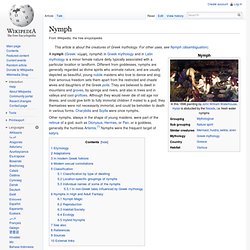

Siren. Siren or sirens may refer to: Most common uses[edit]

Nymph. Etymology[edit] Nymphs are personifications of the creative and fostering activities of nature, most often identified with the life-giving outflow of springs: as Walter Burkert (Burkert 1985:III.3.3) remarks, "The idea that rivers are gods and springs divine nymphs is deeply rooted not only in poetry but in belief and ritual; the worship of these deities is limited only by the fact that they are inseparably identified with a specific locality.

" The Greek word νύμφη has "bride" and "veiled" among its meanings: hence a marriageable young woman. Other readers refer the word (and also Latin nubere and German Knospe) to a root expressing the idea of "swelling" (according to Hesychius, one of the meanings of νύμφη is "rose-bud"). Adaptations[edit] In modern Greek folklore[edit] A Sleeping Nymph Watched by a Shepherd by Angelica Kauffman, about 1780, (V&A Museum no. 23-1886) Modern sexual connotations[edit] The word nymphet is used to identify a sexually precocious girl. Classification[edit] As H.J. Dragons in Greek mythology. Dragons play a role in Greek mythology.[1] Ladon[edit] Lernaean Hydra[edit] Pytho or Python[edit] There are various versions of Python's birth and death at the hands of Apollo.

In the earliest, the Homeric Hymn to Apollo, little detail is given about Apollo's combat with the serpent or its parentage. The Colchian Dragon[edit] The Ismenian Dragon[edit] The Ismenian Serpent, of the spring of Ismene at Thebes, Greece, was slain by the hero Cadmus.[6] It was the offspring of Ares, who later turned the hero into a serpent.
See also[edit] References[edit] External links[edit] Theoi Project - Drakon Hesperios. Satyr. The satyrs' chief was Silenus, a minor deity associated (like Hermes and Priapus) with fertility.

These characters can be found in the only complete remaining satyr play, Cyclops, by Euripides, and the fragments of Sophocles' Ichneutae (Tracking Satyrs). The satyr play was a short, lighthearted tailpiece performed after each trilogy of tragedies in Athenian festivals honoring Dionysus. There is not enough evidence to determine whether the satyr play regularly drew on the same myths as those dramatized in the tragedies that preceded. The groundbreaking tragic playwright Aeschylus is said to have been especially loved for his satyr plays, but none of them have survived. Attic painted vases depict mature satyrs as being strongly built with flat noses, large pointed ears, long curly hair, and full beards, with wreaths of vine or ivy circling their balding heads.
Notice, the goat on the left has a short goat tail, but the Greek satyr on the right has a long horse tail. Other references[edit] Harpy. In Roman mythology, a harpy (Greek: ἅρπυια, harpyia, pronounced [hárpuja]; Latin: harpeia) was one of the winged spirits best known for constantly stealing all food from Phineus.

The literal meaning of the word seems to be "that which snatches" as it comes from the Greek word harpazein (ἁρπάζειν), which means "to snatch". A harpy was the mother of the horses of Achilles sired by the West Wind Zephyros.[1] Hesiod[2] calls them two "lovely-haired" creatures, and pottery art depicting the harpies featured beautiful women with wings. Harpies as ugly winged bird-women, e.g. in Aeschylus' The Eumenides (line 50) are a late development. Roman and Byzantine writers detailed their ugliness.[3] Mythology[edit] A medieval depiction of a harpy as a bird-woman In this form they were agents of punishment who abducted people and tortured them on their way to Tartarus. Aeneas encountered harpies on the Strophades as they repeatedly made off with the feast the Trojans were setting.